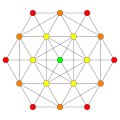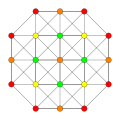 5-demicube |  5-orthoplex |
In 5-dimensional geometry, there are 23 uniform polytopes with D5 symmetry, 8 are unique, and 15 are shared with the B5 symmetry. There are two special forms, the 5-orthoplex, and 5-demicube with 10 and 16 vertices respectively.
Contents
They can be visualized as symmetric orthographic projections in Coxeter planes of the D5 Coxeter group, and other subgroups.







































